This brown butter cake is moist, tender, and absolutely delicious! It’s made with brown butter cake layers and fluffy brown butter cream cheese frosting.
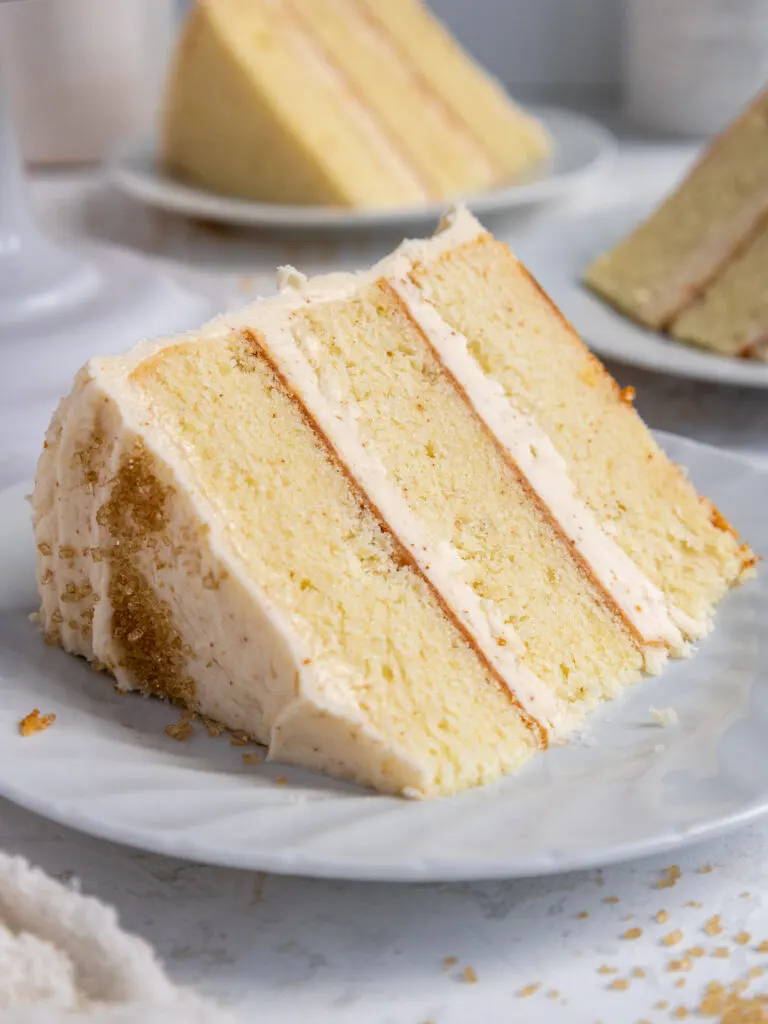
How to Make This Brown Butter Cake
To make sure this cake turns out as amazing as possible, let’s walk through each step together!
I figured it might be helpful to know what tools I use too, so I’ve shared a list below too.
Not all of these are mandatory, but they make the process a lot easier. If you don’t have all these things on hand, feel free to improvise and work with what you have.
- Saucepan
- 4, 7-inch Cake Pans or 3, 8-inch Cake Pans
- Spinning Cake Stand
- Electric Hand Mixer or Stand Mixer
- Serrated Knife
- 10-inch Greaseproof Cake Board or Flat Plate
- Large Offset Spatula
- Rubber Spatula
Step 1: Brown the Butter
The first step is to brown the butter for both the cake layers and the frosting. This can be done in advance to speed up the cooling process, I usually make it the day before I want to make this cake.
Place 2 cups of unsalted butter cut into Tbsp-sized pieces in a large, light-colored pan over medium heat. Stir the butter the entire time with a rubber spatula to keep it moving.
Once melted, the butter will begin to foam and sizzle around the edges. Keep stirring. The butter will turn golden brown in about 5–6 minutes from when you start.
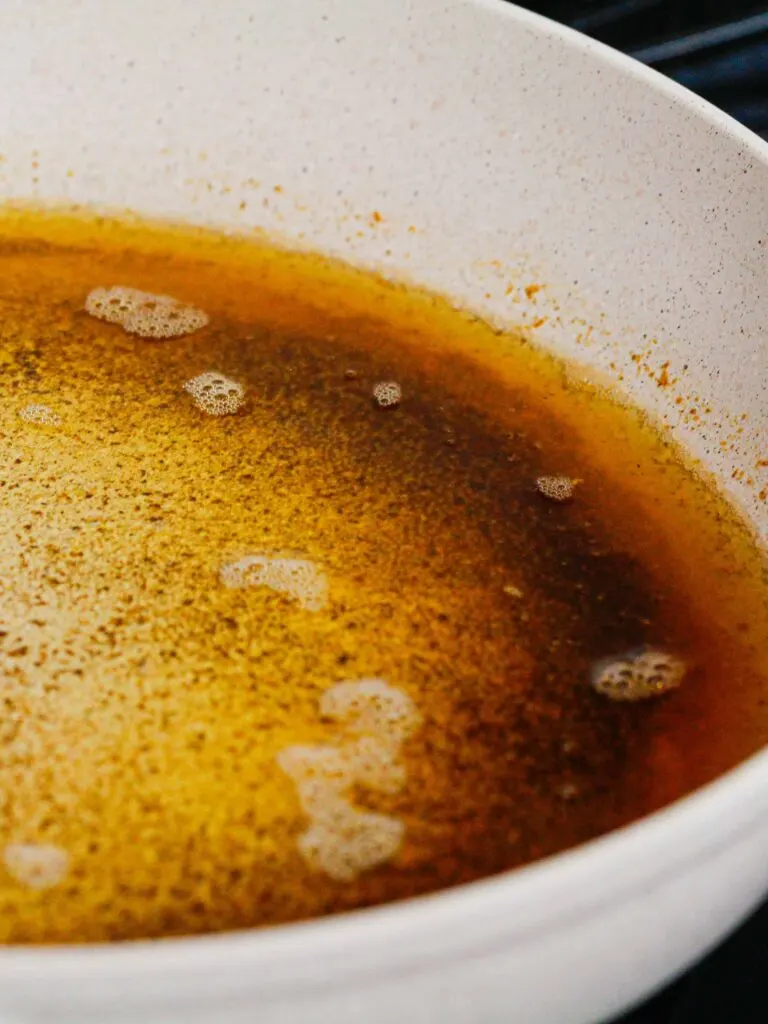
Some foam will subside and the milk solids at the bottom of the pan will be toasty brown. It should have a strong, nutty aroma.
Immediately remove the pan from heat and pour the butter into a heatproof bowl to stop the cooking process. If left in the hot pan, the butter will burn.
Place the bowl in the fridge for 45 minutes to accelerate the cooling process, or until it solidifies and reaches room temperature.
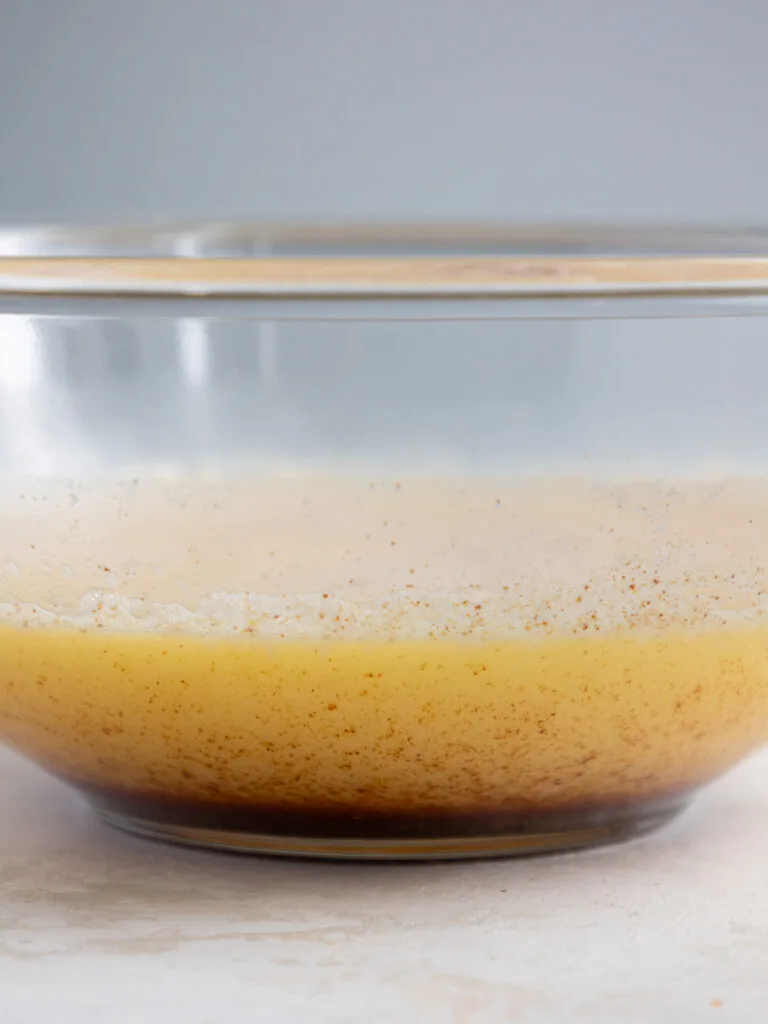
While you start with 2 cups of butter, you’ll find that you’re left with less because of the water that evaporates from the butter during the browning process.
You should be left with about 1 1/2 cups of brown butter.
Step 2: Bake the Brown Butter Layers
Make the brown butter cake layers next following the recipe card at the bottom of this post.
Divide it evenly between the prepared cake pans and bake for 33-36 minutes or until a toothpick comes out with a few moist crumbs.
Remove the cake layers from the oven and let them cool in the pans for about 30 minutes. Or if you’re in a rush, place the pans directly in the freezer to accelerate the cooling process.
Then gently run an offset spatula around the rim of the cake pans to loosen them and flip them onto wire racks to finish cooling.
These layers bake up pretty flat, so leveling them is optional! If you want to level them, use a serrated knife to level the top of each cake layer. I also like to trim away the caramelization around the sides of the layers.

If you’re making these in advance, you can wrap and freeze them at this point.
Step 3: Make the Brown Butter Cream Cheese Buttercream Frosting
While the cake layers bake and cool, make the buttercream frosting.
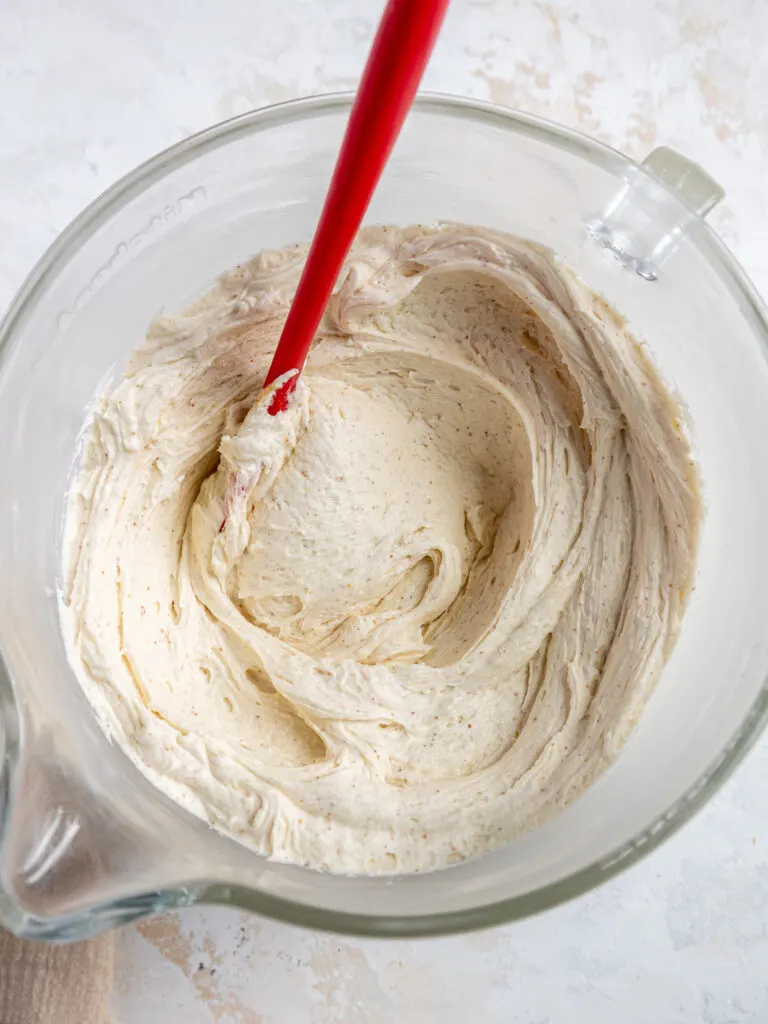
If you want to use a less sweet frosting or regular vanilla frosting, I’d recommend making a batch of my Swiss meringue buttercream or 1.5 batches of my hybrid buttercream and swapping out 1 cup of butter for 3/4 cup of brown butter.
This frosting can also be made in advance if needed and kept in the fridge for up to 2 weeks or in the freezer for a month.
Step 4: Stack and Frost the Cake Layers
Then it’s time to assemble this cake! Stack and frost cake layers on a greaseproof cake board or flat plate. Use a dab of buttercream to help stick the first cake layer to the board.
Spread an even layer of cream cheese buttercream on top of each cake layer with a large offset spatula.
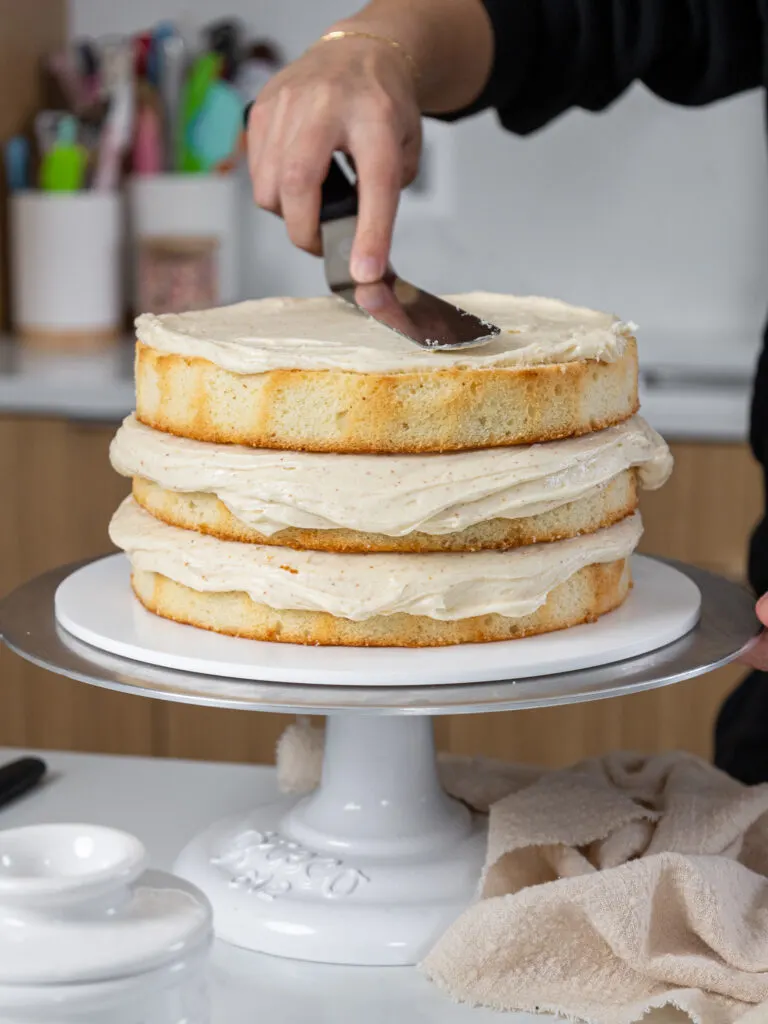
Step 5: Frost the Cake
Spread a thick coat of frosting around the cake to fully cover the cake layers.
Use a large offset spatula or the back of a spoon to create a textured look in the frosting around the cake, then enjoy!

I also like to add a sprinkle of turbinado sugar around the top of the cake for a bit of sparkle and texture, but it’s optional.
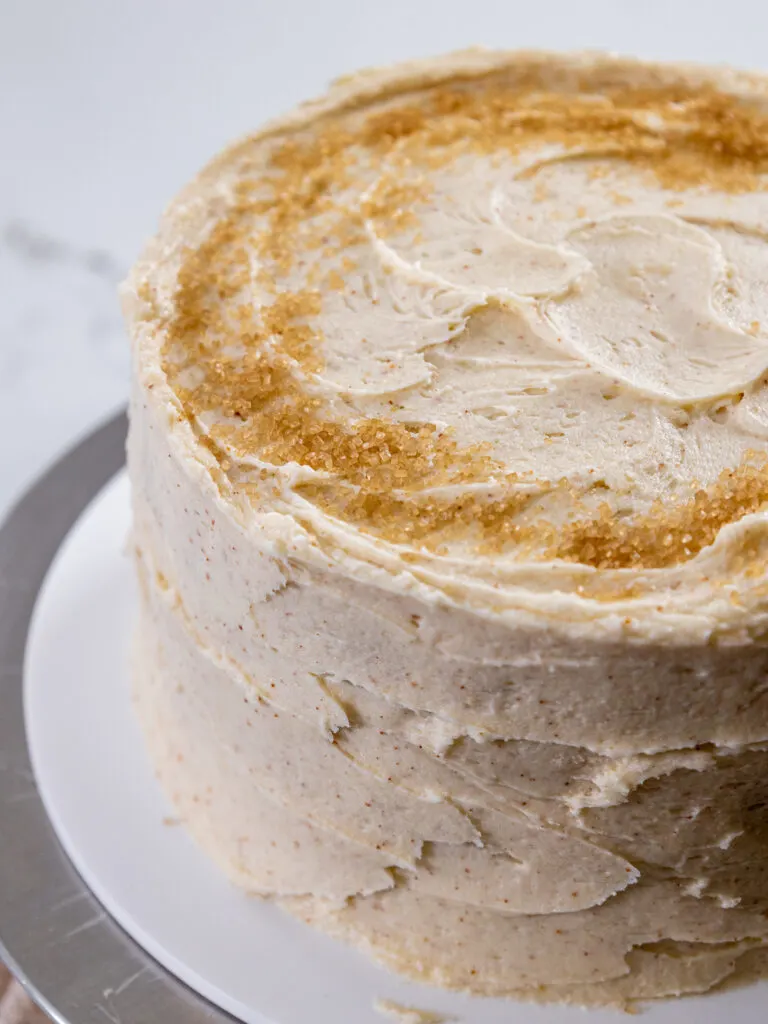
Substitutions and Swaps – Brown Butter Layers
This recipe uses quite a few ingredients and I know you might not have them all on hand. Or if you have food allergies or restrictions, I’ve got you covered.
Below are some swaps and substitutions that can be made in this cake recipe.
- All-Purpose Flour – This recipe turns out best with AP flour, but you can use a gluten-free flour blend or cake flour if that’s what you have on hand.
- Granulated Sugar – I do not recommend changing the type or reducing the amount of sugar because it will change the texture of the cake layers.
- Unsalted Butter – If you only have salted butter on hand, you can use it in place of the unsalted butter in this recipe. Just be sure to omit the salt that this cake recipe calls for. You can also use vegan butter in its place (and also omit the salt)!
- Egg whites – I like to use the pasteurized egg whites that come in a carton, but you can also separate your own egg whites and use 7 large egg whites or 4 whole, large eggs. If you have an egg allergy you can try using flaxseed eggs or a vegan egg replacer.
- Sour Cream – You can also use full-fat yogurt, whole milk, buttermilk, or an alternative yogurt or milk (almond, soy, oat) if you’re dairy-free.
- Vegetable Oil – Any flavorless oil will work in this recipe. Canola or even sunflower oil would work great!
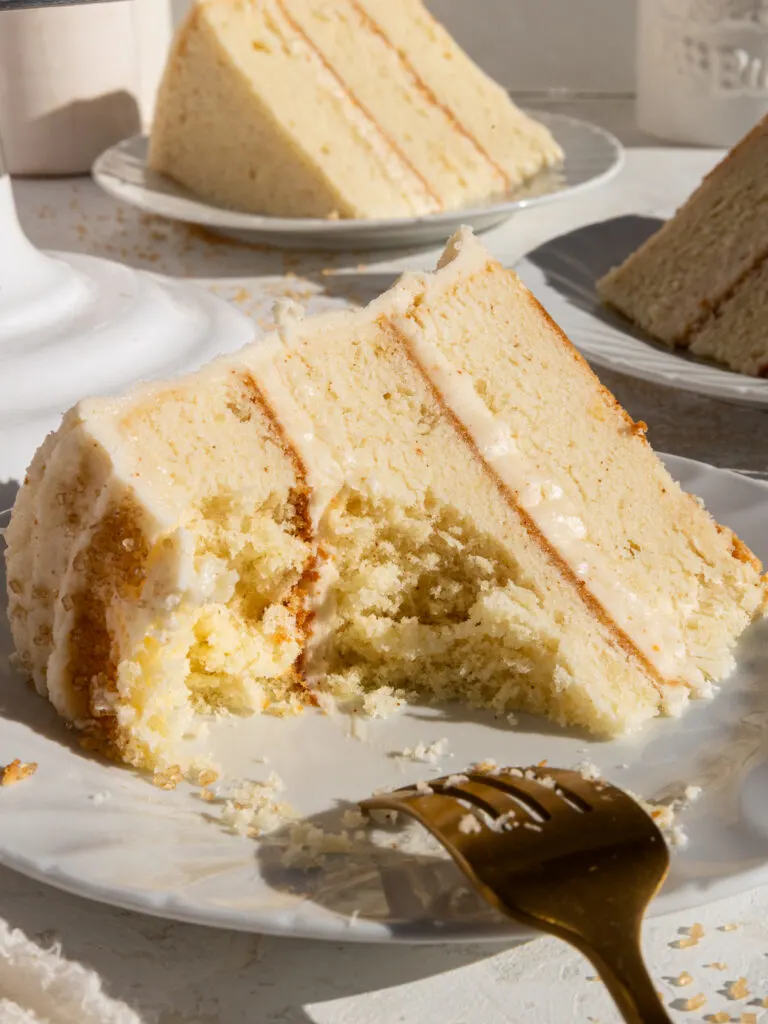
Substitutions and Swaps – Brown Butter Cream Cheese Buttercream Frosting
- Unsalted Butter – If you only have salted butter on hand, you can use it in place of the unsalted butter. Just be sure to omit the salt that this frosting recipe calls for. You can also use vegan butter in its place (and omit the salt)!
- Cream Cheese – Full-fat cream cheese that comes in a block works best. I prefer the Philadelphia brand (not sponsored – just truly the best for baking!).
- Heavy Cream – Whole milk or alternative milk (soy, almond, oat) will work fine in this frosting recipe if that’s what you have on hand.
Recipe Variations
One batch of cake batter makes about 1800 grams or 10 cups. If you plan to use four circular cake pans, add 450 grams of batter into each pan. If you make 3 layers, add 600 grams to each pan.
While I usually make 3, 8-inch cake layers or 4, 7-inch cake layers with this recipe, it can also be used to make 4, 6-inch cake layers, but they will take a few minutes longer to bake.
This recipe can also be used to make a brown butter sheet cake! One batch will make 2, 9 x 13-inch cake layers that are about 1 inch tall.
Bake for 35-40 mins at 350 F / 175 C. I recommend using heating cores if you have them to help large cake layers like this bake more evenly and quickly.
You can also make one 9 x 13-inch cake layer that’s about 2 inches tall, but the bake time will be 45-55 minutes at 350 F/ 175 C.
Tips for Making the Best Brown Butter Cake
- Ingredients at room temp mix together better! Set out any cold ingredients ahead of time.
- Properly measure your flour (spoon into the cup measure, then level). Or better yet, use a kitchen scale to measure your dry ingredients.
- Use a scale to weigh your cake pans as you fill them. It will make the cake layers bake up to the same height and bake more evenly.
- Level the room temperature or thawed cake layers with a serrated knife to make them easier to stack.
- Make sure the buttercream is the right consistency. This will help give the cake proper structure and make it easier to decorate.
- Chill the cake layers in the freezer for about 20 minutes before assembling the cake. It makes them so much easier to stack and frost!
- If your cake layers turn out less than perfect, read my cake troubleshooting guide to see where things might’ve gone awry.
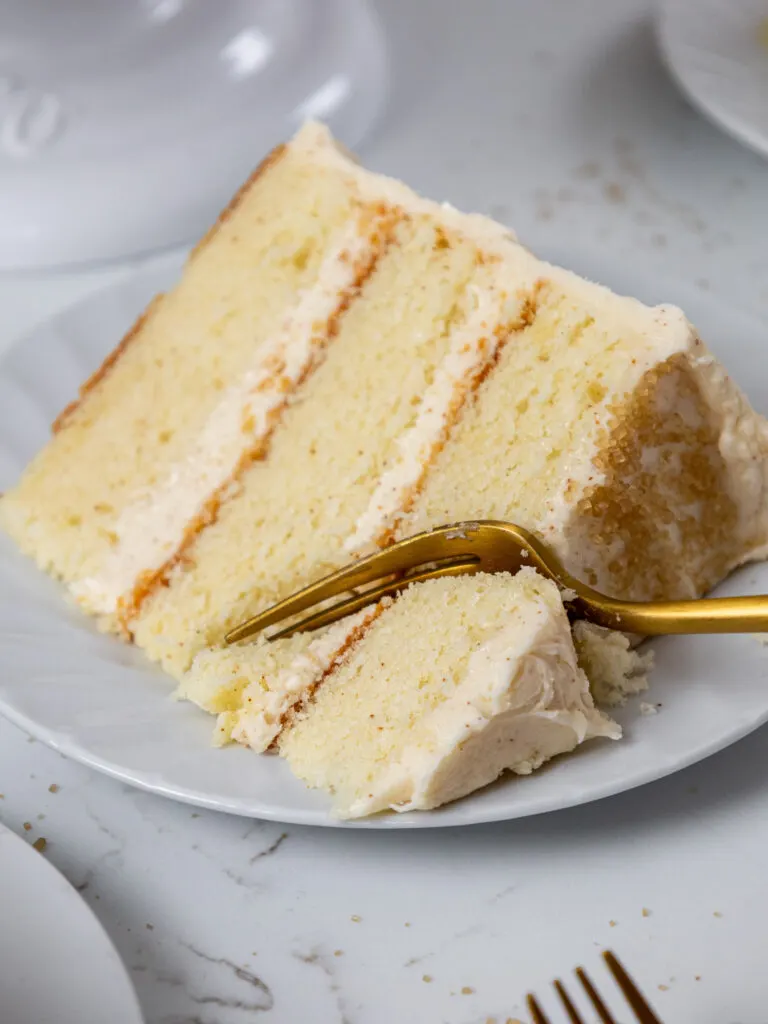
Making this Brown Butter Layer Cake in Advance & Storage Tips
Make these cake layers in advance and freeze them. It breaks the process up and makes it more approachable.
You can also make the frosting can also be made ahead of time too or you can save any leftover frosting! It can be stored in an airtight container in the fridge for up to a week, or in the freezer for up to a month.
Be sure to give it a good stir once it thaws to get the consistency nice and smooth again.
A frosted cake can last in the fridge for up to a week, or in the freezer for up to a month. The buttercream locks in all the moisture, keeping the cake fresh and delicious!
If you cut into the cake and have leftovers, use any remaining frosting to cover the cut section to keep it moist and store it in the fridge for up to a week.
Let Me Know What You Think!
If you make this brown butter cake recipe, I’d love to hear what you think of it! Let me know by leaving a rating and comment below.
And don’t forget to tag me @chelsweets use #chelsweets if you share on social media so that I can see your amazing creations.
Other Recipes You Might Like:
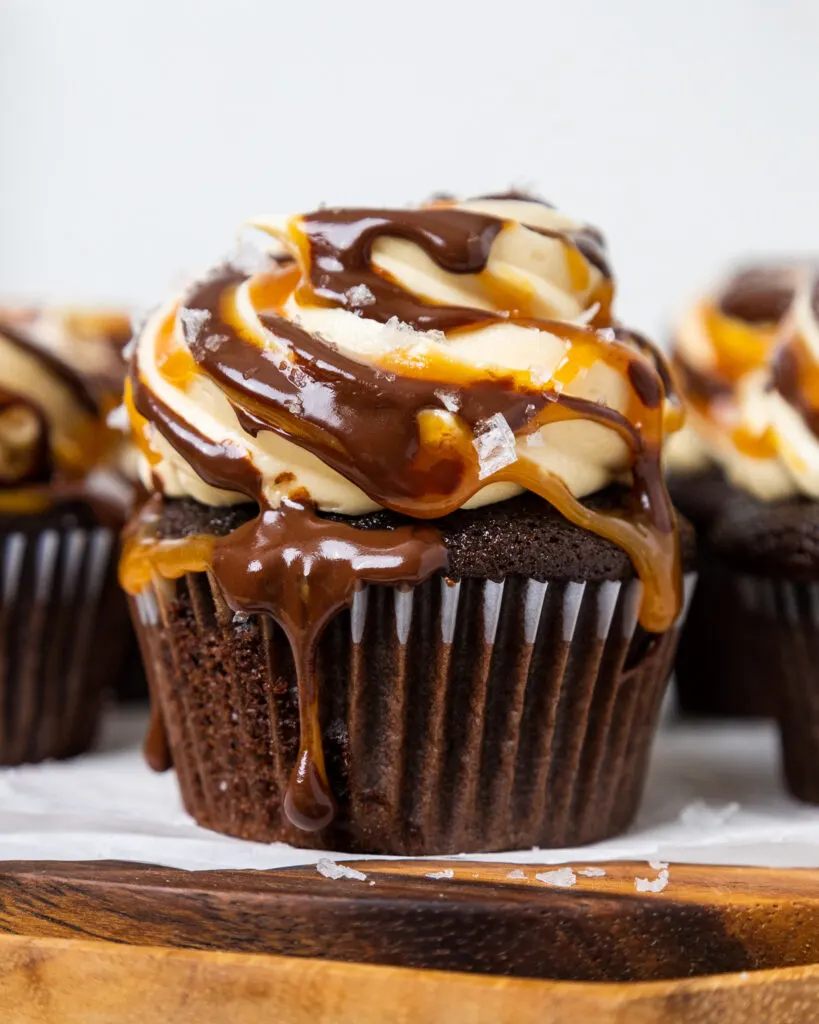
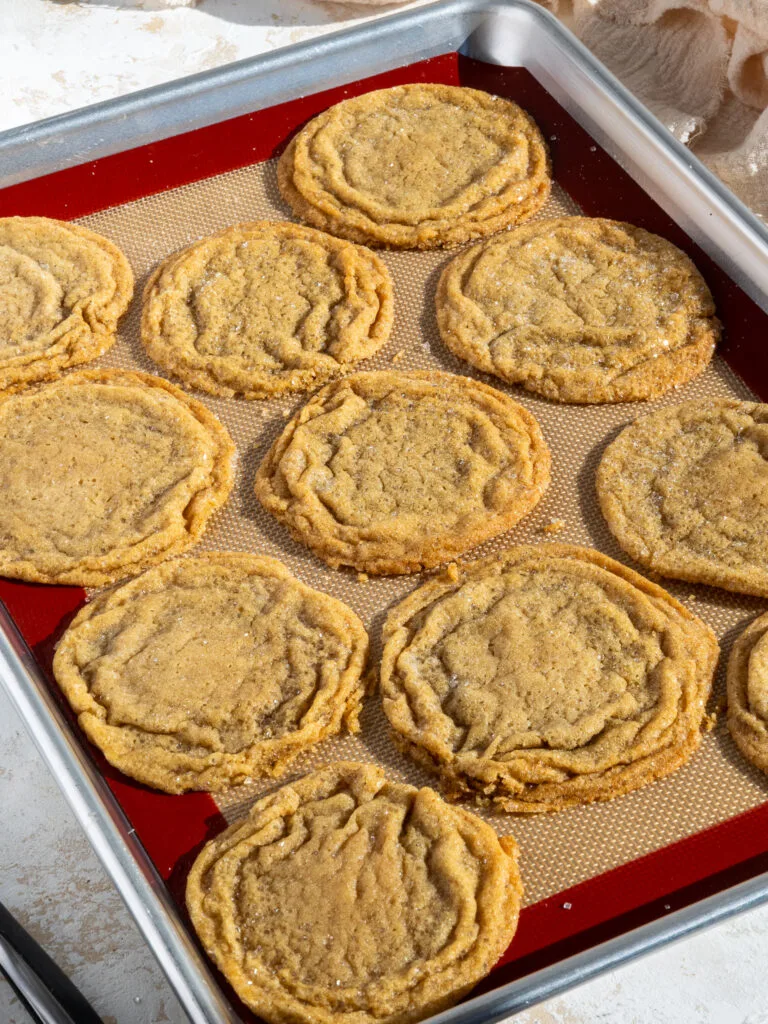
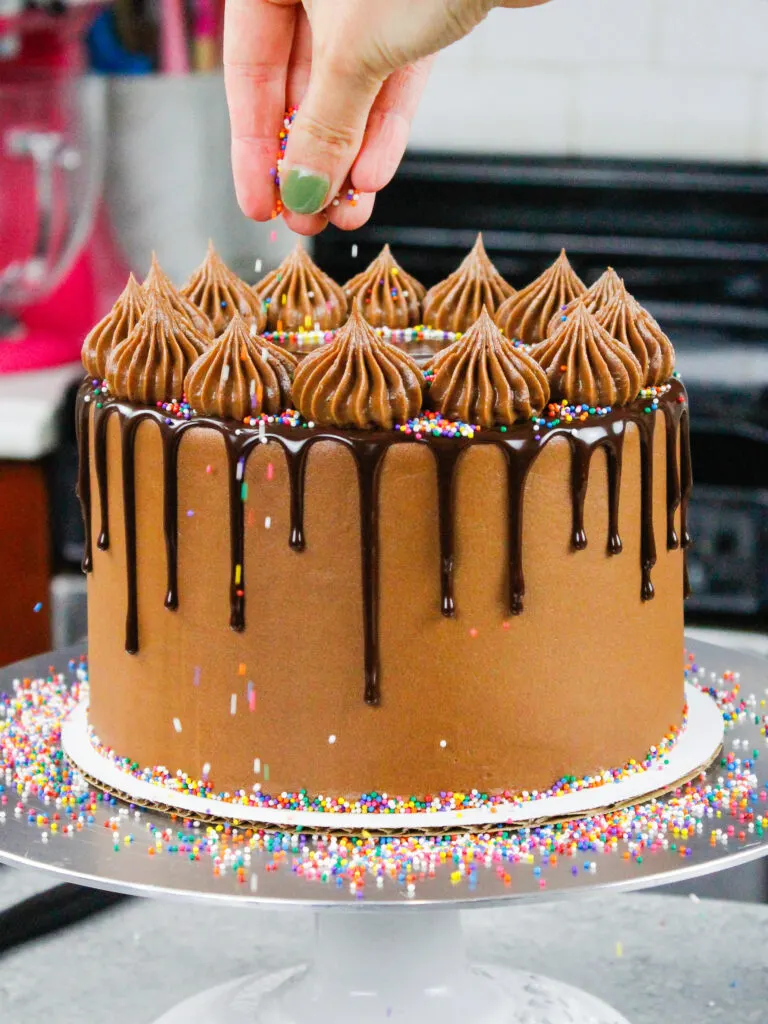

Brown Butter Cake

This brown butter cake is moist, tender, and absolutely delicious! It's made with brown butter cake layers and fluffy brown butter cream cheese frosting!
Ingredients
Brown Butter
- 2 cups unsalted butter, cut into 1-Tbsp sized pieces (452g)
Brown Butter Cake Layers
- 3 cups all-purpose flour (375g)
- 3 cups granulated sugar (600g)
- 2 1/2 tsp baking powder (10g)
- 1 tsp fine salt (6g)
- 3/4 cup brown butter, made above (174g)
- 1 cup pasteurized egg whites from a carton or about 7 large egg whites, room temp (240g)
- 1 1/2 cups sour cream, room temperature (360g)
- 1/4 cup vegetable oil (56g)
- 2 tsp vanilla extract (8g)
Brown Butter Cream Cheese Frosting
- 3/4 cup brown butter, room temp - made above (174g)
- 1 cup or 8 oz. full-fat cream cheese, room temp (226g)
- 1 Tbsp vanilla extract (12g)
- 1/2 tsp fine salt (3g)
- 6 cups powdered sugar (750g)
- 2 Tbsp heavy cream or whipping cream (30g)
Recommend Tools and Equipment
- Heavy Bottomed Saucepan
- 7- or 8-inch round cake pans
- Large offset spatula
- Bench Scraper
- Electric Hand Mixer and Stand Mixer
Instructions
Brown Butter:
- The first step is to brown the butter for both the cake layers and the frosting. This can be done in advance to speed up the cooling process, I usually make it the day before I want to make this cake. Place 2 cups of unsalted butter cut into Tbsp-sized pieces in a large, light-colored pan over medium heat. Stir the butter the entire time with a rubber spatula to keep it moving.
- Once melted, the butter will begin to foam and sizzle around the edges. Keep stirring. The butter will turn golden brown in about 5–6 minutes from when you start. Some foam will subside and the milk solids at the bottom of the pan will be toasty brown. It should have a strong, nutty aroma.
- Immediately remove the pan from heat and pour the butter into a heatproof bowl to stop the cooking process. If left in the hot pan, the butter will burn.
- Place the bowl in the fridge for 45 minutes to accelerate the cooling process, or until it solidifies and reaches room temperature. While you start with 2 cups of butter, you'll find that you're left with less because of the water that evaporates from the butter during the browning process. You should be left with about 1 1/2 cups of brown butter.
Brown Butter Cake Layers:
- Preheat oven to 350°F/175°C. Line four 7-inch or three 8-inch round pans with parchment rounds, and grease with non-stick cooking spray or homemade cake release. I used 7-inch cake pans.
- Mix 3 cups flour, 3 cups sugar, 2 1/2 tsp baking powder, and 1 tsp salt together in a stand mixer with a paddle attachment or hand mixer until fully combined.
- Gradually mix half (about 3/4 cup) of the room-temperature brown butter into the dry ingredients on a low speed. Continue to mix until no large chunks of butter remain, and the mixture looks like moist sand.
- Mix in 1 cup egg whites on low until just incorporated. Scrape the sides and bottom of the bowl as needed with a rubber spatula.
- Then mix in 1 1/2 cups sour cream, 1/4 cup vegetable oil, and 2 tsp vanilla extract on a low speed until fully incorporated. Scrape down the sides of the bowl with a rubber spatula one more time, then beat on a medium speed for about 30 seconds to make sure everything is properly mixed together. This also helps lighten the texture of the cake layers.
- Divide the batter evenly between the cake pans (450g per pan if you make 4 layers, 600g per pan if you make 3 layers). Bake for 33-36 minutes or until a toothpick comes out with a few moist crumbs. Rotate the pans halfway through to help them bake evenly.
- Let the pans cool for 10 minutes, then run a small offset spatula around the perimeter of the pan to separate the cake from the pan.
- Place the cake layers into the freezer for 30 minutes to accelerate the cooling process. Once the layers are fully cooled, carefully flip the pans, and remove the layers.
- These cake layers bake up pretty flat, but I like to use a serrated knife to level the tops and remove any caramelization around the sides of the layers. This step is optional but makes the cake a lot easier to frost. You can also trim the layers, then wrap and freeze them if you're making them in advance.
- If you make these cake layers in advance and freeze them, let them thaw for about 15 minutes before making the cake. The cake layers should still be slightly cold to the touch, which will make it easier to assemble the cake.
Brown Butter Cream Cheese Buttercream Frosting:
- While the cake layers bake and cool, make the cream cheese buttercream frosting.
- In the bowl of a stand mixer or a large bowl, beat the remaining brown butter (about 3/4 cup) of unsalted butter and 1 cup of cream cheese on a medium speed for 30 seconds with a stand mixer and paddle attachment or hand mixer until smooth.
- Mix in 1 Tbsp of vanilla extract and 1/2 tsp salt on a low speed.
- Gradually mix in 6 cups of powdered sugar and 2 Tbsp of heavy cream on a low speed.
- Continue to mix on a low speed for a few minutes until the desired consistency is reached. If the frosting seems too thick, add in additional cream (1 Tbsp at a time). If the frosting seems too thin, add more powdered sugar (a quarter of a cup at a time).
- Cover the buttercream flush with plastic wrap to prevent crusting, then set aside.
Assembling This Brown Butter Cake:
- Stack and frost the cake layers on a greaseproof cake board or flat plate using a dab of frosting to help stick the first cake layer to the board.
- Spread an even layer of brown butter cream cheese buttercream on top of each cake layer with a large offset spatula.
- Top with the next cake layer and repeat until all the cake layers are stacked. Spread a thick coat of frosting around the cake to fully cover the cake layers.
- Use a large offset spatula or the back of a spoon to create a textured look in the frosting around the cake, then enjoy! I also like to add a sprinkle of turbinado sugar around the top of the cake for a bit of sparkle and texture, but it's optional.
Notes
If you need to make any substitutions or swaps in this recipe, please see the section in the post above on ingredient substitutions.
Recipe Variations
One batch of cake batter makes about 1800 grams or 10 cups. If you plan to use four circular cake pans, add 450 grams of batter into each pan. If you make 3 layers, add 600 grams to each pan.
While I usually make 3, 8-inch cake layers or 4, 7-inch cake layers with this recipe, it can also be used to make 4, 6-inch cake layers, but they will take a few minutes longer to bake.
This recipe can also be used to make a brown butter sheet cake! One batch will make 2, 9 x 13-inch cake layers that are about 1 inch tall.
Bake for 35-40 mins at 350 F / 175 C. I recommend using heating cores if you have them to help large cake layers like this bake more evenly and quickly.
You can also make one 9 x 13-inch cake layer that's about 2 inches tall, but the bake time will be 45-55 minutes at 350 F/ 175 C.
Tips for Making the Best Brown Butter Cake
- Ingredients at room temp mix together better! Set out any cold ingredients ahead of time.
- Properly measure your flour (spoon into the cup measure, then level). Or better yet, use a kitchen scale to measure your dry ingredients.
- Use a scale to weigh your cake pans as you fill them. It will make the cake layers bake up to the same height and bake more evenly.
- Level the room temperature or thawed cake layers with a serrated knife to make them easier to stack.
- Make sure the buttercream is the right consistency. This will help give the cake proper structure and make it easier to decorate.
- Chill the cake layers in the freezer for about 20 minutes before assembling the cake. It makes them so much easier to stack and frost!
- If your cake layers turn out less than perfect, read my cake troubleshooting guide to see where things might've gone awry.
Making this Brown Butter Layer Cake in Advance & Storage Tips
Make these cake layers in advance and freeze them. It breaks the process up and makes it more approachable.
You can also make the frosting can also be made ahead of time too or you can save any leftover frosting! It can be stored in an airtight container in the fridge for up to a week, or in the freezer for up to a month.
Be sure to give it a good stir once it thaws to get the consistency nice and smooth again.
A frosted cake can last in the fridge for up to a week, or in the freezer for up to a month. The buttercream locks in all the moisture, keeping the cake fresh and delicious!
If you cut into the cake and have leftovers, use any remaining frosting to cover the cut section to keep it moist and store it in the fridge for up to a week.
Nutrition Information
Yield
24Serving Size
1Amount Per Serving Calories 461Total Fat 20gSaturated Fat 12gTrans Fat 1gUnsaturated Fat 6gCholesterol 55mgSodium 364mgCarbohydrates 68gFiber 0gSugar 54gProtein 5g

Laurel
Sunday 5th of May 2024
Do you think you could add coconut and chopped pecans to the batter?
Donna
Sunday 19th of May 2024
@Chelsweets, I’m looking to make a Butter Pecan cake. How many grams of chopped pecans do you think could be added to this recipe?
Chelsweets
Sunday 5th of May 2024
For sure, I think that would be delicious Laurel!!
Kimberly
Monday 29th of April 2024
Can I make cupcakes with this recipe? I made it as a layer cake it was delicious. Thank you
Chelsweets
Sunday 5th of May 2024
Hi Kimberly,
You totally can! Fill the liners 3/4 full and bake them at 350 F / 175 C for 18-21 minutes, or until a toothpick inserted in the center comes out with a few moist crumbs. It should make 2-3 dozen (will vary a bit based on the size of your cupcake liners and pans).
Or I also have a very similar brown butter cupcake recipe, which might be easier! Here's the link: https://chelsweets.com/brown-butter-cupcakes/
Hope that helps, happy baking!
Ashley White
Friday 5th of January 2024
What do you do with the butter if you make it the day before? Does it stay in the fridge?
Chelsweets
Sunday 7th of January 2024
Hi Ashley,
Great question! It can be stored at room temperature for up to a day. I usually just leave it out overnight on the counter, but you can store it in the fridge if you want! Just be sure to set it out a few hours before you need to use it so it can come to room temperature. Hope that helps, happy baking!
Tracey
Wednesday 22nd of November 2023
So I did everything exactly the way you said lol, but I could not get the dry ingredients with the brown butter completely ride of some smaller pieces. It definitely looked like sand, but there were some pieces that didn’t break down. The batter has some small little lumps in it. The pans are in the oven now so I’m hoping it comes out ok even with the small little pieces that didn’t dissolve all the way.
Chelsweets
Monday 27th of November 2023
Hi Tracey,
Don't worry! If there are little bits of butter in the batter, they will dissolve as the cake layers bake and the layers should turn out just fine!! Hope that helps for the future, happy baking!
Sandy
Tuesday 7th of November 2023
Is it a tablespoon or teaspoon for the vanilla in the buttercream? The ingredients list and directions are not the same amount….??
Chelsweets
Sunday 12th of November 2023
Hi Sandy,
Apologies for the confusion, my pregnancy brain has been the worst!! It should be a Tablespoon, I've updated the directions to correct that typo. Thank you for letting me know!